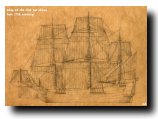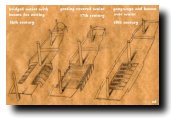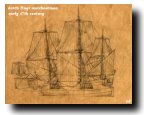T H E M I D - 1 7 T H C E N T U R Y
|
WITH THE shift of naval warfare tactics from boarding and melee to a longer-range gun battle in the late-16th Century, refinements of the tactic to amass firepower were needed. The forming of combatants into a long line of battle was the obvious solution. This approach required more powerful guns, more stable firing platforms, as well as sturdy hulls. (The battle-line was to remain as the primary battle fleet tactic until the line-breaking tactic was introduced late in the next century.)
 ship-of-the-line From the mid-century on the large three-decker warships (with three full gun decks) were beginning to join the large European navies and add even more weight to the fleets' broadsides. As the smaller ships were in disadvantage in these exchanges, the warships were divided in the British Admiralty's 1653 Fighting Instructions (which also introduced the line tactic) into six distinct classes according to their sizes and uses: The ships-of-the-line:
The British built their warships to carry a large number of guns and sail deeper than their French adversaries, which, as a consequence, were better gun platforms that could fire their guns in higher seas than the British. In fact, as the French captured English warships for addition to their fleets, they removed many of the guns to make them better sailers and combatants. On the other hand, the French ships' excessive decorations of the most fervent Baroque era tended to severely reduce the seaworthiness of the ships. The French ships were also designed with heavy bow- and stern-chaser armament for fighting galleys in possible windless conditions in the Mediterranean. The Dutch built their warships as relatively lightweighted and shallow-drafted (due to the Dutch geography) which gave them great mobility but also vulnerability in battle.
 waist bridging development The waist, the "bay" between the quarterdeck and forecastle (which had been covered with beams for protection nets in the 16th Century and later with wooden gratings), was bridged along the ship sides by gangways and the remaining opening was spanned by beams on top of which the ship's boats were stored. As the century came to a close, the high-rising stern with the tall, heavily decorated escutcheon changed into a lower structure that offered better still stability and sail handling. Already in the beginning of the century, developments to the rigging were forthcoming: The topsail continued to grow in size and eventually exceeded the mainsail in size. With the re-instatement of reefs (first encountered in the 13th Century, they had however disappeared by the early 16th Century) for taking in a portion of sail according to weather conditions, the flexibility of the sails could be increased and in some cases, especially in the mercantile navy, where less crew meant more profit, that led to discarding the topgallant sails and handling only the mainsails and (now-enlargened) topsails. It is also notable that during this period the "steepness" of the sides of the top- and topgallant sails (ie. the relative size difference between the yards of a mast), gradually lessened, so that the relatively small topgallant sail of the 16th Century grew considerably in size, and the development continued in the next century as well. The introduction of studding sails (although similar additions had been in use at least a century earlier), bended to special yards that were extended from the ends of main and top yards, gave a possibility to spread an enormous amount of canvas to propel the ship. Another addition to the arsenal of sails were the staysails around in 1670. These were, accordingly, attached to the stays that supported the masts from the front. First they appeared in stays between the masts and later, as jibs, in stays over bowsprit. The braces and bowlines that crowded the stays and the presence of the top spritsail mast made the adding of staysails difficult, but by the end of the next century the staysails were already occupying every possible stay in a ship. Phineas Pett's gigantic Sovereign of the Seas (renamed Royal Sovereign after the Restoration) of 1637 not only carried the most complete rigging so far, sporting even the new royal sail, but it also sported 100 cannon on three decks and could have held its own even in the battle formations that amassed to fight in the Revolutionary Wars a century and a half later. The Sovereign was the first British galleon-type ship with the lower portion of the stern built with rounded lines, whereas the French and Dutch retained the flat sterns until the next century, when both started to use similar rounded lines under the escutcheon.
 Dutch fluyt Also the mercantile shipping improved during the period. The Dutch developed the fluyt (flojt) merchantman, with a hull that was wide at the waterline and tapered sharply as it rose. This approach maximized the cargo capacity, but the tapering hull also meant that the duties, determined by the width of the ship, were less that way... The merchantmen usually carried a normal complement of sails, with topsails, in the larger ships even topgallants, along with a variety of guns, although their lack of use and the lack of gunnery practice often rendered them more to of nuisance value.
There were of course exceptions. Along with the larger, more
heavily armed merchantmen, there were extensively escorted vessels
that were not only heavily manned with soldiers but also properly
armed, like the fabled Spanish treasure galleons that carried
the wealth of the Spanish Caribbean possessions (and from the
Philippines) to the king's coffers in home-Spain. The Dutch East Indies Company also sent fleets of strongly armed merchantmen to its possessions in the East Indies (Indonesia) to carry back the invaluable crops of spice grown there. The ships departed with large crews because the voyage was long, lasting several months for one leg, and the toll as dead or ill was always heavy. Also defending against pirates or opposing sea powers required more manpower on board. During wartime, these ships doubled as warships. |
ENTRANCE
THE TWO-MASTED SHIP
THE CARRACK
THE GALLEON
THE SHIP-OF-THE-LINE
THE FULL-RIGGED SHIP
STUDY SOURCES

|
text and drawings © e t dankwa 6 January 2000
|